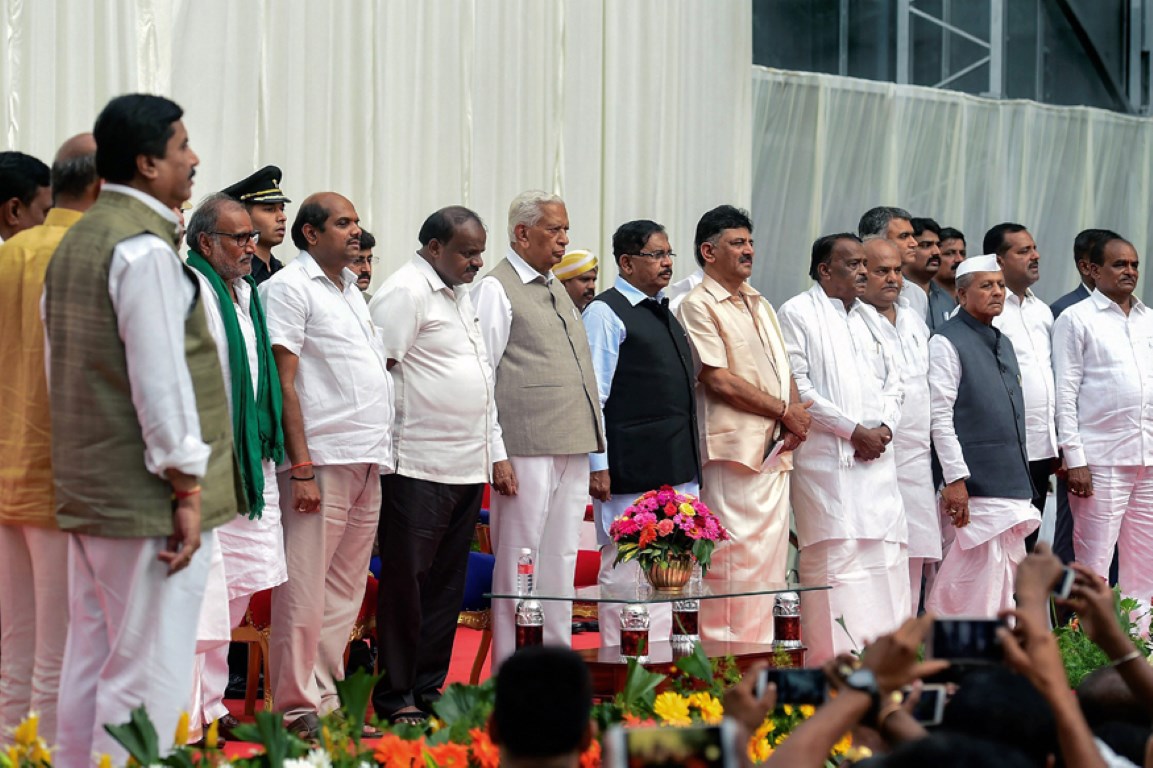Karnataka cabinet expanded
June 7, 2018 | Expert Insights

Twenty-five ministers for the southern Indian state of Karnataka were sworn in on June 6th. The cabinet is being formed almost two weeks after JD(S) leader HD Kumaraswamy was sworn in as Chief Minister. Portfolios have not yet been announced.
Background
The southern Indian state of Karnataka took its present shape in 1956, after the states of Mysore and Coorg (Kodagu) merged with the Kannada-speaking districts of the former states of Bombay and Hyderabad, and Madras. Mysore state was made up of 10 districts: Bangalore, Kolar, Tumkur, Mandya, Mysore, Hassan, Chikmagalur (Kadur), Shimoga, and Chitradurga. The first ever assembly election in Karnataka was held in 1952 and it resulted in a victory for the Indian National Congress. K. Chengalaraya Reddy became the first ever chief minister of the state.
The Government of Karnataka is a democratically elected body with the governor as the constitutional head. The governor is appointed for five years and appoints the chief minister and his council of ministers, who are democratically elected in Legislative Assembly elections once every five years. The governor remains the head of the state, but the day-to-day functioning is undertaken by the chief minister and his council of ministers. There are 224 seats in the Karnataka Legislative Assembly. For a party to declare majority and form a government, it has to win at least 113 seats either by itself or through a coalition.
The 2018 Karnataka elections were extremely contentious, with the Indian Prime Minister Narendra Modi himself campaigning for the BJP. The southern state registered a voter turnout of over 72% on May 12th. The results were announced on 15th May, with BJP emerging as the single largest party in the state with 104 seats in the Assembly. As the election results were declared, the Congress reached out to former Prime Minister Deve Gowda’s JD(S) to keep the BJP out of power in Karnataka. The two parties, who had secured 78 and 38 seats respectively, agreed to form a coalition.
BJP leader BS Yeddyurappa resigned from the post of Chief Minister minutes before the floor test to prove his party’s majority. The JD(S)-Congress JD(S) coalition declared victory and JD(S) leader HD Kumaraswamy was sworn in as the Chief Minister of Karnataka on 23rd May. Congress deputy, G Parameshwara was sworn in as Deputy Chief Minister.
Analysis
Twenty-five ministers were sworn in by Karnataka Governor Vajubhai Vala on 6th June at the Raj Bhavan. Under the coalition agreement, 22 Congress MLAs and 12 JD(S) MLAs would hold positions in the state cabinet. The ministers sworn in on Wednesday included 10 from the JD(S) and 15 from the Congress. Thirteen ministers are holding the position for the first time. A majority of the ministers (11) are from the Old Mysuru region. Thirteen of the 30 districts in Karnataka are unrepresented in the new cabinet.
New ministers from the Congress include former Power Minister D.K. Shivakumar, former Agriculture Minister Krishna Byregowda, and former Food and Civil Supplies Minister U. T. Abdul Khader. Also sworn in as the only woman in the cabinet was Congress MLC Jayamala. Among the JD(S) ministers were Chief Minister’s brother H D Revanna and G T Deve Gowda, who defeated former Chief Minister Siddaramaiah in parts of his home district of Mysore. BSP MLA N. Mahesh and an independent candidate from Ranibennur, R. Shankar, also received places in the cabinet.
“Cabinet formation took a while since a coalition is involved,” CM Kumaraswamy said. “Cabinet berths have been allocated and portfolios will be allocated soon. There is bound to be some dissatisfaction among those who did not make it. We will try to resolve them,” Deputy CM Parameshwara added. There are still seven posts vacant as the current government can have up to 34 cabinet members. Observers have noted that it is likely that the JD(S) and Congress did not fill all the positions on Wednesday in order to leave room for those unsatisfied by the results.
A number of Congress and JDS ministers have expressed their dissatisfaction with the list of ministers, including Lingayat leader and former irrigation minister, M B Patil, Hirekerur MLA B.C. Patil, Hoskote MLA Nagaraj, and Bhadravati MLA Sangameshwar. “Senior leaders such as (JDS) Basavaraj Horatti, A.H. Vishwanath and B. Satyanarayana are believed to been upset with the ‘treatment meted out to them’,” The Hindu reported.
Assessment
Our assessment is that both the Congress and JD(S) have inducted ministers after looking at the constituencies they represent. Most major voting constituencies in the state are represented in the new cabinet. We believe that the Congress and JD(S) could control dissidence by accommodating those dissatisfied in the remaining seats or by giving them other positions.








Comments